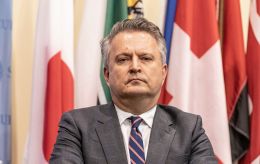Russia's successes on front do not justify its human and material losses -ISW
 Russian forces cannot continually suffer colossal losses in the war against Ukraine (Illustrative photo: Getty Images)
Russian forces cannot continually suffer colossal losses in the war against Ukraine (Illustrative photo: Getty Images)
The Russian army is suffering immense losses in both material resources and personnel. However, the successful advancement and capture of Ukrainian territories do not justify these losses, as the Russian military cannot sustain them indefinitely, reports the Institute for the Study of War (ISW).
During intensive Russian offensive operations in September and October, Russian forces lost nearly 200 tanks, over 650 armored vehicles, and around 80,000 soldiers. However, the enemy managed to capture approximately 1,500 square kilometers of Ukrainian territory.
In an interview with The Telegraph on November 9, British Defense Secretary John Healey stated that, according to British military intelligence, Russian losses in October reached a new high. The average daily losses of Russian troops in October 2024 amounted to 1,345 soldiers per day or about 41,980 fatalities.
The UK Ministry of Defense, citing data from the General Staff of the Ukrainian Armed Forces, had previously reported that in September 2024, Russian troops experienced record-high average daily losses of 1,271 soldiers, or about 38,130 casualties.
According to the ISW report, Russian forces have lost approximately 80,110 soldiers over the last two months. This figure is about 20,000 higher than the total number of US casualties over nearly 20 years of operations in Iraq and Afghanistan.
Record advancement
Data compiled by Jakub Janovsky, the founder of the Dutch intelligence site Oryx, indicates that in September and October, Russian forces also lost 197 tanks, 661 armored personnel carriers, and 65 artillery systems with calibers over 100 mm across the entire front line.
In exchange for these losses, Russian troops captured and recaptured a total of 1,517 square kilometers of Ukrainian territory and areas in the Kursk region.
Over the past two months, Russian forces intensified their offensive operations near Kupiansk in the Kharkiv region, as well as in the towns of Selydove, Kurakhove, and Vuhledar in the Donetsk region. They managed to advance slightly further than in the past two years. Recently, Russian forces captured Vuhledar and Selydove but have not yet achieved operationally significant successes, as their advances have mainly been across open fields and small settlements.
"Russian forces will eventually make operationally significant gains if Ukrainian forces do not stop ongoing Russian offensive operations, but the Russian military cannot sustain such loss rates indefinitely, especially not for such limited gains. The ISW previously observed data indicating that Russian forces have lost at least five divisions' worth of armored vehicles and tanks in Pokrovsk Raion alone since October 2023," the report states.
Never-ending colossal losses
The ISW also noted that Russian forces have likely amassed a significant amount of equipment at priority sections of the front. However, the depletion of Soviet-era tanks and armored vehicles, combined with current production rates of armored vehicles, will likely make such losses unsustainable in the long term.
On October 31, US Secretary of Defense Lloyd Austin stated that the Russian army is losing approximately 1,200 soldiers a day, which totals 36,000 personnel per month.
Recently, the Institute for the Study of War observed signs that the Russian military is attempting to recruit enough soldiers to replace losses on the front lines. Russian President Vladimir Putin acknowledged Russia's ongoing labor shortage and its reliance on migrants to address this issue during his speech at the Valdai Club on November 7.
The ISW highlighted that Russia is dependent on coercing migrants into joining the military to meet its workforce needs. The Russian army is almost certainly unable to sustain daily losses of over 1,200 soldiers indefinitely while Putin tries to avoid another forced mobilization of reservists.
Even forced mobilization of reservists will not resolve the larger problem Putin faces - finding enough people to work in Russia's industrial sectors while simultaneously maintaining the front lines.
Assault meat
Certain Russian military bloggers continue to express dissatisfaction with disproportionately high personnel losses, and broader discontent within the Russian ultranationalist blogging community may impact Putin's calculations in the future.
A former Russian instructor for Storm-Z and blogger complained that training assault troops take at least six months. However, Russian military command treats assault troops as assault meat requiring little preparation, with their main task being to catch drones and debris.
According to the blogger, the losses of Russian infantry are high due to the Russian tactic of sending small assault groups in multiple successive waves in an attempt to suppress the Ukrainian Armed Forces. He described this tactic as stupid and poorly organized, concluding that the Russian successes do not seem proportional to the irreversibly spent resources - both human and material.
Recently, the Russian military blogger community criticized the deaths of specialized drone operators, whom commanders sent on assaults as punishment.
"The Russian milblogger community recently criticized the deaths of specialized drone operators whom their commanders sent on assaults as punishment, and the continued use of Russian servicemembers, particularly specialized troops, in unorganized, highly attritional, infantry-led "meat" assaults that result in disproportionately small gains may continue to anger the milblogger community – a group towards which the Kremlin has shown itself to be especially sensitive," the ISW report states.
Frontline situation
According to ISW, Russian forces have advanced in three areas, but the Ukrainian Armed Forces regained control of positions near Siversk and Pokrovsk.
The Kremlin is attempting to recruit residents from Central Asian countries as labor forces. However, this process is hindered by strong hostility toward these migrants from the Russian population.
The UK Ministry of Defence noted that in October, Russian losses at the front were the highest since the start of the full-scale war. On average, the Russian army lost 1,354 soldiers per day.

